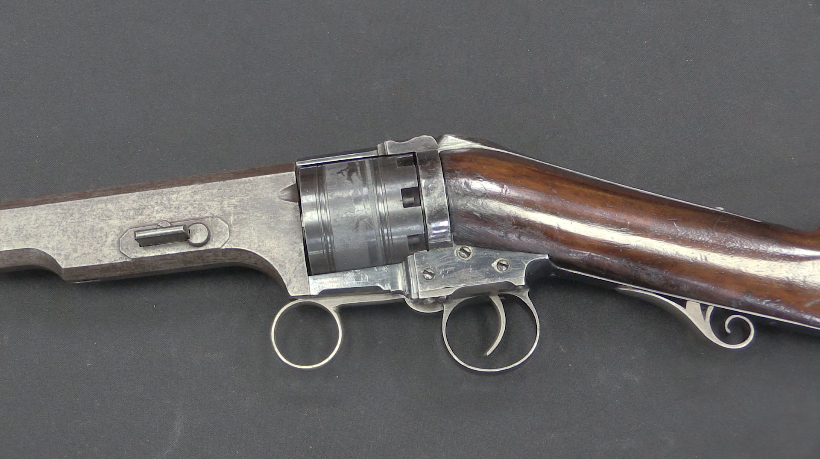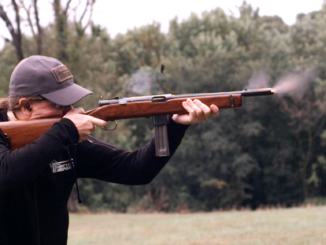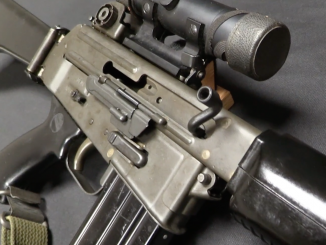After he failed to win US military adoption of his toggle-locked rifle design, John Pedersen went looking for other countries that might be interested in the gun. One of these was Japan, which experimented with toggle-locked Pedersen rifles and carbines for several years in the early/mid 1930s. This particular one is serial number 8, and has a scope mounting rail attached to it. It functions like a normal Pedersen rifle, but has a rotary magazine instead of the en bloc clip used in the US trial and British-produced rifles.
Related Articles

Revolving Rifles
Colt Paterson No.1 Carbine (Video)
Sam Colt’s very first work was done in Baltimore, but this ended fairly quickly, and it was with his subsequent move to Paterson New Jersey that the first true production Colt firearms were made. Colt […]

Submachine Guns
An Early .45 ACP Reising Model 50 at the Range
The Reising was adopted by the US Marine Corps and used in campaigns through 1942 and early 1943, and it garnered a pretty poor reputation for reliability on the islands of the Pacific. However, it’s […]

Select-fire Rifles
AR-18 and AR-180: Can Lightning Strike Twice for Armalite?
The AR-18 has its genesis in the AR-10. I n an effort to develop a less expensive version of that rifle, Armalite created the AR-12, an experimental rifle which used a stamped or bent sheet […]

Toggle system seems reinvented in this rifle. Front joint, the key factor of delaying action with superimposed supporting points working succesively from lower to upper units looks very different from British sample. If made by Japanese staffs it deserves high grade of admiring. Though the overall concept is unchanged, same genius of design approach is also present at other differences made at other sections of the rifle.
Is that a scope rail on the side?
I don’t know about this example, but there was a war manga short story depicting a Japanese Pedersen with a scope offset to the left. The story, taking place at Guadalcanal, is purely fictional, but I do appreciate the author having done some sort of tech research. Americans attempting to bum rush the sniper late in the story get ventilated because they don’t know that his weapon is a semi-auto and not an old bolt-action. The Japanese sniper wasn’t even sitting in a tree while emptying his magazine. Sadly, he dies in a duel with a one-eyed American sniper armed with a scoped Garand. Both guys headshot each other.
What is the name of that manga? It sounds really interesting.
I can’t read Japanese, but the overall series’ title could be roughly translated as “battlefield tales.” The manga was drawn by Leiji Matsumoto, and apart from some elements in the individual stories that popped up in Matsumoto’s later works, each story is unique in having very “killable” main characters. Very few of the war stories have a happy ending.
Beautiful, intricate machining. Probably too much so for an issue service weapon. And considering the decline in quality of materials and machining Japan showed during the war, I think getting issued a substandard Pederson would get exciting as soon as you pulled the trigger…….
As mentioned by others I too like level of machining and fit. The only question I’d have is how well would this mechanism work when contaminated.
On contrast of other toggle systems in which the joints are fixed in their recesses, Pedersen concept contains most of those enagements as movable. This may produce a roller and swager effect under pressure for disintegrating the contaminating particules.
Regarding the extraction issues with the Pederson rifle, it just struck me but could those have been overcome with a fluted chamber? I’m not sure if the concept was invented yet (I know the FG-42 had one), but I was just wondering if that could have been a potential tweak that would have improved it’s chances of being adopted without the need for lubricated cases (not the actual solution wasn’t already quite ingenious and adequate in itself.)
I wish they made a non-detachable rotary mag rifle today.